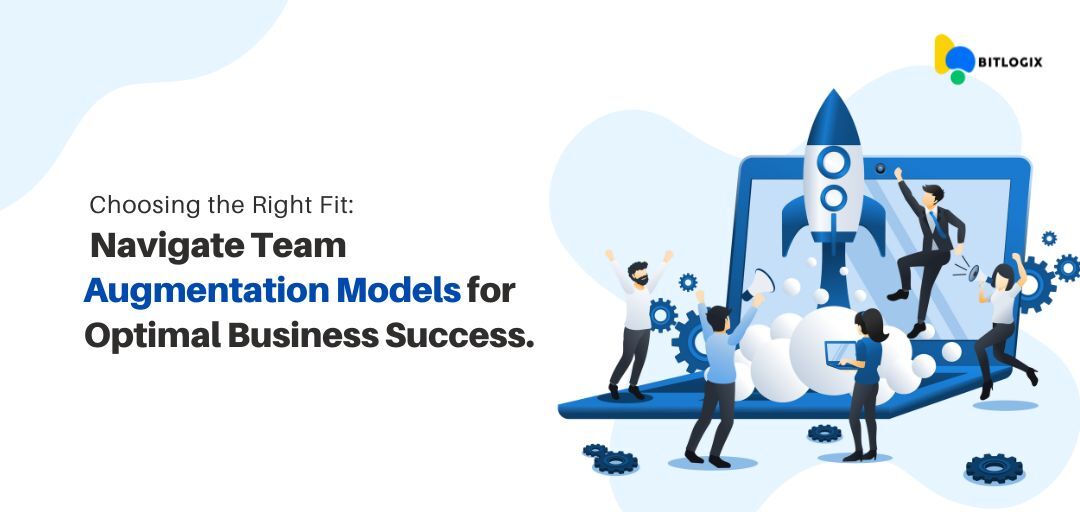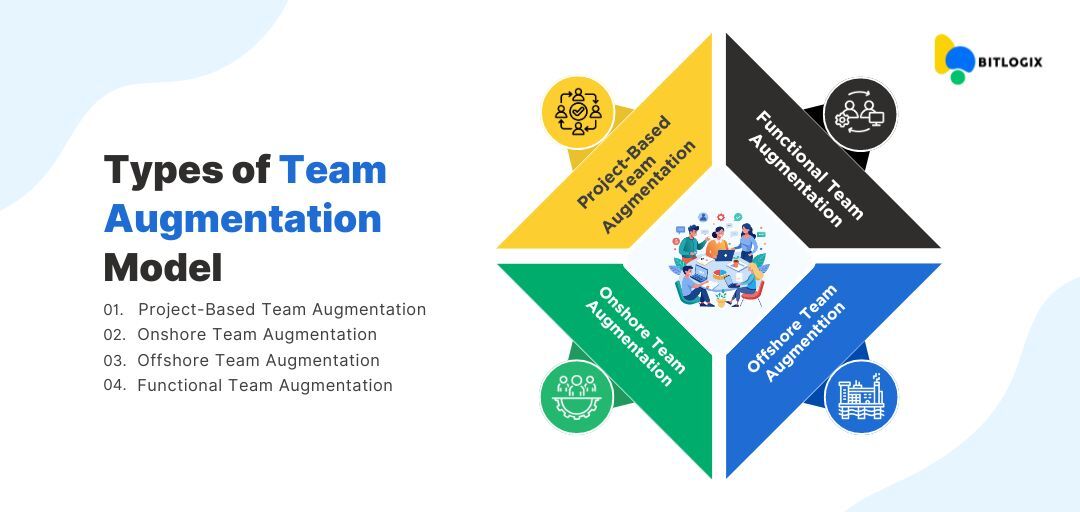
With the rapid development of technology, the business world is changing quickly. If your business cannot keep up with the growing change, you’ll left behind in the competition. Maintaining a competitive edge demands constant adaptation, and many organizations struggle to adapt to the constant changes.
Skill gaps, unexpected workload, and the need for specialized expertise cause barriers to the success of your business. These hurdles can ultimately hinder your ability to meet deadlines and achieve your best performance goals.
But don’t worry! Team augmentation models offer a powerful solution to fix these challenges. This blog will guide you in choosing the right model, ensuring you find the perfect fit to propel your business forward and leave the competition.
How Wrong Team Augmentation Model Impact Your Business?
When you end up selecting the wrong team augmentation model, it leaves disastrous impacts on your business. As we all know, hiring for specific skill sets takes time; but still, there is no guarantee that the resources will fit in the team and culture. There might be chances new team members don’t understand your workflows, lack the necessary skills, or disrupt team dynamics. What can be the result of this issue? Delays in project deadlines, wasted resources, and a growing sense of frustration due to a lack of skilled resources.
A Wrike report states that 43% of project managers cite a lack of resources as a primary reason for project delays.
Continue reading the blog to have a detailed analysis of different team augmentation modes, to make the right choice for your team.
Types of Team Augmentation Model:

1. Project-Based Team Augmentation:
Project-based staff augmentation model allows an organization to onboard external resources for specific projects. These resources work on a short-term basis for the company, once the project is delivered, the organization sets the resource free. This model is suitable for organizations that aim to quickly scale up or down the team. The organization can easily onboard resources for a particular project until delivery, with no long-term commitment after project completion.
Now let’s explore the pros and cons of this model.
Pros of Project-Based Team Augmentation Model
1. Flexibility:
There are no long-term commitments in this model. Based on project needs, you can easily scale up or down the team.
2. Focus on Core Business:
This model allows your in-house staff to focus on the core business activities while the augmented staff will take care of project-specific staff.
3. Risk Mitigation:
Reduces the risk associated with long-term hiring and the potential need for layoffs after project completion.
Cons of Project-Based Team Augmentation Model
1. Integration Challenges:
Integrating remote resources into your existing teams can be a challenge. Fixing cultural differences can be time-consuming which might affect the productivity of the resources.
2. Knowledge Transfer Issues:
Due to dependency on external resources, transferring knowledge from the augmented staff to the internal team is difficult, which can lead to potential gaps after the project ends.
3. Communication Barriers:
As augmented staff is working remotely in different time zones which leads to communication barriers.
2. Onshore Team Augmentation:
In the onshore staff augmentation model, you can bring a highly qualified team located in the same country as your business. To fill a certain skill gap, you can hire them as full-time employees, or contractors and also avail the services of the staffing agency.
In this model, you have more chances of cultural alignment as there will be no geographical differences. Moreover, timezone compatibility will ensure effective and easy communication. This model is highly recommended for projects that demand close collaboration within teams. Here’s a breakdown of the key aspects.
Pros of Onshore Team Augmentation
1. Time Zone Alignment:
Remote and in-house teams can have easier communication because of the same time zone. The same time zone will also facilitate real-time collaboration and ensure quick responses to urgent issues.
2. Cultural Compatibility:
Due to the same geographic location, they shared the same cultural values which helped them better understand local business practices, market conditions, and customer expectations. Moreover, cultural compatibility ensures swift and smooth integration in the teams.
3. Legal and Regulatory Compliance:
Within the same country, the employees have the same labor laws, tax regulations, and easier compliance requirements which reduce the risk of legal issues.
Cons of Onshore Team Augmentation
1. High Cost:
In this model, the employer has to bear high costs as they hire resources from the same country. The labor cost will be higher. There are additional expenses for benefits, taxes, and compliance with local labor laws.
2. Talent Pool Limitations:
As this model only offers you skilled resources within the same country which Limit the availability of certain skill sets or specialized talent locally.
3: Geographical Constraints:
Limitations in hiring within a specific region or country, may not align with the best talent available globally.
3. Offshore Team Augmentation:
Companies hire external talent from different geographic locations with lower labor costs. This model allows access to a global talent pool and expertise not readily available locally, which is suitable for remote management of tasks or projects. Offshore staff augmentation provides remote team expansion, remote staffing solutions, and extended offshore teams, all without going through extensive hiring processes. Unlike traditional hiring methods, where employees are recruited directly into the company’s workforce, offshore staff augmentation offers collaboration with external agencies or service providers to access specialized talent. This model offers a pathway to unparalleled talent acquisition and operational excellence.
Pros of Offshore Staff Augmentation:
1. Cost Savings:
The offshore augmentation model offers resources from different locations where labor rates are lower as compared to onshore options. This can offer businesses an edge who are looking to stretch their budget with cost-effective labor.
2. Access to a Wider Talent Pool:
In offshore augmentation, the global talent pool is accessible with specialized expertise. Sometimes finding the specialized skills in the same locality becomes a challenge for organizations.
3. 24/7 Availability:
The staff augmentation model facilitates different time zones that can offer extended work hours in case of strict deadlines. So due to the flexibility of work hours or even round-the-clock coverage projects with urgent deadlines or those requiring continuous monitoring can be delivered on time.
Cons of Offshore Team Augmentation:
1. Communication Challenges:
Time zone differences and language barriers can make communication difficult. This can lead to misunderstandings, delays, and frustration.
2. Cultural Differences:
Cultural norms and work styles can vary greatly between countries. Integrating offshore staff effectively requires a clear understanding of these differences to ensure smooth collaboration.
3. Security Concerns:
Depending on the type of work being done, data security can be a concern. It’s crucial to choose a reputable provider with strong security protocols in place.
Functional Team Augmentation:
This model facilitates bringing only a functional resource to the team. It brings professionals to perform specific functions, such as marketing, HR, or IT support, to complement the existing team.
The functional staff augmentation model brings specialists to specific departments or functions, like marketing or software development. This ensures targeted expertise but can limit collaboration and create knowledge silos within your team.
Pros of Functional Team Augmentation:
1. Specialized Expertise:
This model focuses on adding staff with specific skills in a particular function, like human resources, marketing, software development, or customer service. This model allows you to address a specific skill gap in your team.
2. Quick Integration:
Since the augmented staff is focused on a specific function, they can often integrate with the existing team more quickly. They understand the relevant processes and terminology, allowing them to become productive contributors sooner.
Cons of Functional Staff Augmentation:
1. Collaboration Challenges:
While focused expertise can be beneficial, it can limit collaboration with other parts of the team. The augmented staff might not be able to have an entire view of the project, which can potentially cause challenges to cross-functional communication and teams.
2. Lack Of In-House Skill Development:
The in-house team may depend on the augmented staff for tasks within their specific function, hindering internal skill development.
3. Dependency:
When the functional team completely takes over the core function, it can create a dependency on the augmented staff. This dependency further leads to vulnerabilities for the team and disrupts the team functions.
Final Words
In today’s era team augmentation is imperative for business success. Choosing the right team augmentation model is essential to fulfill your business needs. Whether you need flexibility with project-based, seamless communication, cost savings, or specialized skills these models can offer you all the required benefits. All you need to do is select the right model and you are ready to accelerate your business success.
At BITLogix, we offer different types of team augmentation solutions to help you scale efficiently and meet your business goals with ease. Contact BITLogix today to find the perfect fit for your team augmentation needs and drive your business forward.